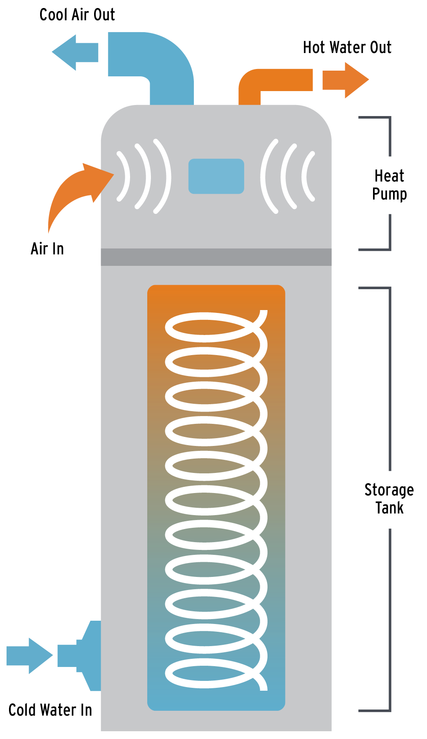Hi, I’m Eric Strandberg with Seattle City Light. I work in education and outreach for building electrification. 
For a few years now, my wife and I have been looking for ways to lower our carbon footprint, and we thought our house would be a good place to start. When we did an inventory of our household energy consumption, we realized that we had a gas furnace, gas water heater, a gas stove, and a gas dryer. We also had 2 gasoline cars. If we could convert some or all of these to electric, then a high percentage of our consumption, at least here in Seattle City Light territory, would be carbon neutral, as most of City Light’s power is generated via hydroelectric and City Light offsets the remaining emissions.
It seemed like an easy first step would be to swap out our gas water heater for an electric water heater. There are two basic types; simple resistance heaters like we have seen for decades, and modern heat pump types (HPWH). When operating in heat pump mode, heat pump water heater technology is up to 2-4 times more efficient than conventional water heaters, so we decided to double our impact and go that way. (They are electric and efficient). I went to City Light’s website and found lots of good information and links.
The Technology
 But, let’s back up a bit. What is a heat pump? A heat pump is just a device that transfers energy (heat), from one place to another, via a refrigerant. Most houses already have at least one heat pump: your refrigerator. That’s right—a refrigerator moves heat out of the enclosure and into the kitchen. That is why there is often warm air around the refrigerator. So, a heat pump is just sort of working in reverse, taking warmth out of the surroundings, and transferring it into the water tank. The Northwest Energy Efficiency Alliance (NEEA) has more details on this subject if you are interested.
But, let’s back up a bit. What is a heat pump? A heat pump is just a device that transfers energy (heat), from one place to another, via a refrigerant. Most houses already have at least one heat pump: your refrigerator. That’s right—a refrigerator moves heat out of the enclosure and into the kitchen. That is why there is often warm air around the refrigerator. So, a heat pump is just sort of working in reverse, taking warmth out of the surroundings, and transferring it into the water tank. The Northwest Energy Efficiency Alliance (NEEA) has more details on this subject if you are interested.
Considerations
One thing I needed to be sure about was would a HPWH work in my house. A typical HPWH wants to be in a space where there is plenty of air around it (about 1,000 cubic feet), and temperatures between 40-90 degrees Fahrenheit. A garage or unfinished basement is ideal for this. Some conventional water heaters are installed in small laundry rooms or even closets, and these spaces would need ventilation or modifications for it to work most efficiently. In my case, it would be in a semi-finished basement near my washer and dryer, so not a problem. For more details on this, check out this link to Energy Star.
The next thing is electricity. Is there enough capacity in my breaker panel, and do I have electricity near the old water heater location? If you have an old-style resistance electric water heater that you are replacing, then you should be ok on both counts, since they both require about 30 amps (220v). But, if you are replacing a gas water heater*, you will need to run significant electrical capacity for the HPWH, you might also need to upgrade your breaker panel. This is because, most HPWHs are what is called hybrid HPWHs. This means that most of the time, they will work in the very efficient heat pump mode, but sometimes, they need to use electric resistance as a back-up to heat the water quickly. The heat pump process is fairly slow, but if the unit is sized correctly, you should normally not run out of hot water. But, say you had guests over and everybody took shower in the morning. The basic heat pump would not be able to keep up, so the electric elements in the tank heat up the water faster, and nobody has a cool shower. Those electric elements require a lot of electricity, so that is why you need the extra wiring. The City of Seattle has a great FAQ if you are planning an electrical project. Major manufacturers are launching 120V 15 amp HPWH products, including a plug-in version intended to help with the electrical capacity issue in late 2022 or early 2023. (As long as there are no supply chain issues.)
I had plenty of capacity in my panel since I upgraded that to 200 amps during a remodel, so I contacted some suppliers to get at least three bids. After brief site visits and reviewing their bids, I chose an installer that was responsive and had a HPWH that met the City Light criteria for a pass-through rebate for my project.** A good place to find qualified contractors is Comfort Ready Homes or Hot Water Solutions. On the scheduled day, the installer took care of hooking up the plumbing and electrical, and even took my old water heater away.
Results
As far as hot water goes, I haven’t noticed any difference. Just the same old, reliable hot water. I haven’t had a chance to really analyze my electric bill, as there have been a few other changes, so it might be difficult to track, but my gas consumption has gone down.
A few things I have noticed and didn’t anticipate:
- The HPWH does make a sound like an old refrigerator, that could be a problem in a different setting. (For example: if it was on the other side of a bedroom wall.) Not a problem for me because it is down in the basement, but if the house is quiet, I can hear it operating.
- The HPWH blows out cool air like an air conditioner. Again, not a problem for me, and it could be a bonus in the summer, but in a different setting it might be a problem. (More on this topic in a future article.)
- The HPWH needs to be able to drain water that is generated from its normal operation just like an air conditioner, and like an air conditioner it can help to dehumidify the space, which in a basement is usually a good thing. Once again, not a problem in my case because there is a basement floor drain nearby but, it could be an issue in a different situation. My high efficiency gas furnace has condensed water that it pumps in tubing to the same floor drain..
There are a variety of motivations to go to a newer technology; energy savings, cost savings***, better quality and added features. In this case, I just get plenty of good old hot water, which is what I had before. I do get new feature; I can program it for when I am away on vacation. As far as cost savings, yes, I will save money over time, it will just take a few years. But I will save energy, and in my case, lowering my carbon footprint was my primary goal.
* An important note for DIYers, replacing a gas water heater requires that you cut and cap the gas line. There is a significant fire and health hazard in doing this and you want to ensure you are properly trained to do this. You may also need an electrical and/or plumbing permit; check your local code requirements. If you hire a plumber, make sure they have the proper licenses to perform the work and offer a warranty.
**Most utilities reference NEEA’s Qualified Products List for eligibility requirements. NEEA Tier 3 or 4 offer the best efficiency and a higher rebate. The Qualified Product List is at https://neea.org/img/documents/residential-unitary-HPWH-qualified-products-list.pdf
*** Due to the high efficiency of HPWHs, NEEA estimates you’ll save $217 per year ($2,168 over the lifetime of the water heater) compared to a conventional electric water heater—energy savings is an important consideration when comparing cost.
